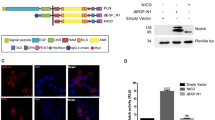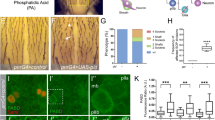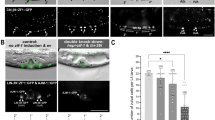Abstract
The coordination of signals from different pathways is important for cell fate specification during animal development. Here, we define a novel mode of crosstalk between the epidermal growth factor receptor/Ras/mitogen-activated protein kinase cascade and the LIN-12/Notch pathway during Caenorhabditis elegans vulval development. Six vulval precursor cells (VPCs) are initially equivalent but adopt different fates as a result of an inductive signal mediated by the Ras pathway and a lateral signal mediated by the LIN-12/Notch pathway1. One consequence of activating Ras is a reduction of LIN-12 protein in P6.p (ref. 2), the VPC believed to be the source of the lateral signal. Here we identify a ‘downregulation targeting signal’ (DTS) in the LIN-12 intracellular domain, which encompasses a di-leucine-containing endocytic sorting motif. The DTS seems to be required for internalization of LIN-12, and on Ras activation it might mediate altered endocytic routing of LIN-12, leading to downregulation. We also show that if LIN-12 is stabilized in P6.p, lateral signalling is compromised, indicating that LIN-12 downregulation is important in the appropriate specification of cell fates in vivo.
This is a preview of subscription content, access via your institution
Access options
Subscribe to this journal
Receive 51 print issues and online access
$199.00 per year
only $3.90 per issue
Buy this article
- Purchase on Springer Link
- Instant access to full article PDF
Prices may be subject to local taxes which are calculated during checkout





Similar content being viewed by others
References
Greenwald, I. Caenorhabditis elegans II (eds Riddle, D. L., Blumenthal, T., Meyer, B. J. & Priess, J. R.) 519–541 (Cold Spring Harbor Press, Cold Spring Harbor, New York, 1997)
Levitan, D. & Greenwald, I. LIN-12 protein expression and localization during vulval development in C. elegans. Development 125, 3101–3109 (1998)
Stevens, J. L., Cantin, G. T., Wang, G., Shevchenko, A. & Berk, A. J. Transcription control by E1A and MAP kinase pathway via Sur2 mediator subunit. Science 296, 755–758 (2002)
Singh, N. & Han, M. sur-2, a novel gene, functions late in the let-60 ras-mediated signaling pathway during Caenorhabditis elegans vulval induction. Genes Dev. 9, 2251–2265 (1995)
Wilkinson, H. A. & Greenwald, I. Spatial and temporal patterns of lin-12 expression during C. elegans hermaphrodite development. Genetics 141, 513–526 (1995)
Wilkinson, H. A., Fitzgerald, K. & Greenwald, I. Reciprocal changes in expression of the receptor lin-12 and its ligand lag-2 prior to commitment in a C. elegans cell fate decision. Cell 79, 1187–1198 (1994)
Burdine, R. D., Branda, C. S. & Stern, M. J. EGL-17 (FGF) expression coordinates the attraction of the migrating sex myoblasts with vulval induction in C. elegans. Development 125, 1083–1093 (1998)
Grant, B. & Greenwald, I. Structure, function, and expression of SEL-1, a negative regulator of LIN-12 and GLP-1 in C. elegans. Development 124, 637–644 (1997)
Fire, A., Harrison, S. W. & Dixon, D. A modular set of lacZ fusion vectors for studying gene expression in Caenorhabditis elegans. Gene 93, 189–198 (1990)
Sandoval, I. V., Martinez-Arca, S., Valdueza, J., Palacios, S. & Holman, G. D. Distinct reading of different structural determinants modulates the dileucine-mediated transport steps of the lysosomal membrane protein LIMPII and the insulin-sensitive glucose transporter GLUT4. J. Biol. Chem. 275, 39874–39885 (2000)
Kirchhausen, T. Adaptors for clathrin-mediated traffic. Annu. Rev. Cell Dev. Biol. 15, 705–732 (1999)
Dietrich, J. et al. Molecular characterization of the di-leucine-based internalization motif of the T cell receptor. J. Biol. Chem. 271, 11441–11448 (1996)
Dittrich, E., Haft, C. R., Muys, L., Heinrich, P. C. & Graeve, L. A di-leucine motif and an upstream serine in the interleukin-6 (IL-6) signal transducer gp130 mediate ligand-induced endocytosis and down-regulation of the IL-6 receptor. J. Biol. Chem. 271, 5487–5494 (1996)
Ehrlich, M., Shmuely, A. & Henis, Y. I. A single internalization signal from the di-leucine family is critical for constitutive endocytosis of the type II TGF-beta receptor. J. Cell Sci. 114, 1777–1786 (2001)
Kil, S. J. & Carlin, C. EGF receptor residues leu679, leu680 mediate selective sorting of ligand-receptor complexes in early endosomal compartments. J. Cell. Physiol. 185, 47–60 (2000)
Fitzgerald, K., Wilkinson, H. A. & Greenwald, I. glp-1 can substitute for lin-12 in specifying cell fate decisions in Caenorhabditis elegans. Development 119, 1019–1027 (1993)
Grant, B. & Hirsh, D. Receptor-mediated endocytosis in the Caenorhabditis elegans oocyte. Mol. Biol. Cell 10, 4311–4326 (1999)
Fares, H. & Greenwald, I. Genetic analysis of endocytosis in Caenorhabditis elegans: coelomocyte uptake defective mutants. Genetics 159, 133–145 (2001)
Nonet, M. L. Visualization of synaptic specializations in live C. elegans with synaptic vesicle protein-GFP fusions. J. Neurosci. Methods 89, 33–40 (1999)
Hubbard, E. J., Wu, G., Kitajewski, J. & Greenwald, I. sel-10, a negative regulator of lin-12 activity in Caenorhabditis elegans, encodes a member of the CDC4 family of proteins. Genes Dev. 11, 3182–3193 (1997)
Heitzler, P. & Simpson, P. Altered epidermal growth factor-like sequences provide evidence for a role of Notch as a receptor in cell fate decisions. Development 117, 1113–1123 (1993)
Jacobsen, T. L., Brennan, K., Arias, A. M. & Muskavitch, M. A. Cis-interactions between Delta and Notch modulate neurogenic signalling in Drosophila. Development 125, 4531–4540 (1998)
Chitnis, A., Henrique, D., Lewis, J., Ish-Horowicz, D. & Kintner, C. Primary neurogenesis in Xenopus embryos regulated by a homologue of the Drosophila neurogenic gene Delta. Nature 375, 761–766 (1995)
Heitzler, P., Bourouis, M., Ruel, L., Carteret, C. & Simpson, P. Genes of the Enhancer of split and achaete-scute complexes are required for a regulatory loop between Notch and Delta during lateral signalling in Drosophila. Development 122, 161–171 (1996)
Dubois, L., Lecourtois, M., Alexandre, C., Hirst, E. & Vincent, J. P. Regulated endocytic routing modulates wingless signaling in Drosophila embryos. Cell 105, 613–624 (2001)
Mello, C. & Fire, A. Caenorhabditis elegans: Modern Biological Analysis of an Organism (eds Epstein, H. F. & Shakes, D. C.) 451–482 (Academic, San Diego, 1995)
Miller, D. M. III & Niemeyer, C. J. Expression of the unc-4 homeoprotein in Caenorhabditis elegans motor neurons specifies presynaptic input. Development 121, 2877–2886 (1995)
Priess, J. R. & Hirsh, D. I. Caenorhabditis elegans morphogenesis: the role of the cytoskeleton in elongation of the embryo. Dev. Biol. 117, 156–173 (1986)
Ambros, V. Cell cycle-dependent sequencing of cell fate decisions in Caenorhabditis elegans vulva precursor cells. Development 126, 1947–1956 (1999)
Tamura, K. et al. Physical interaction between a novel domain of the receptor Notch and the transcription factor RBP-J kappa/Su(H). Curr. Biol. 5, 1416–1423 (1995)
Acknowledgements
We thank M. Stern for the egl-17p::LacZ plasmid and helpful advice on making the modified egl-17 promoter; R. Waterston for anti-MH27 antibody; M. Han for the sur-2(ku9) strain; H. Fares for reagents and much helpful advice; K. Simpson for help with backcrossing integrated arrays; B. Grant for anti-sera against endocytic markers; D. Levitan for advice on immunostaining; R. Ruiz for technical assistance; and B. Grant, O. Hobert, S. Jarriault, X. Karp, G. Struhl and A. Tomlinson for discussion and critical reading of the manuscript. D.S. was supported by a National Science Foundation predoctoral fellowship and an NIH National Institute on Aging training grant, coordinated by R. Liem. I.G. is an Investigator of the Howard Hughes Medical Institute.
Author information
Authors and Affiliations
Corresponding author
Ethics declarations
Competing interests
The authors declare that they have no competing financial interests.
Supplementary information
41586_2002_BFnature01234_MOESM1_ESM.doc
Supplementary Information 1: The downregulation targeting signal (DTS) is conserved in other nematode LIN-12/Notch proteins (DOC 77 kb)
41586_2002_BFnature01234_MOESM2_ESM.doc
Supplementary Information 2: LIN-12(γDTS)::GFP behaves like LIN-12(+)::GFP in cell fate decisions other than VPC specification. (DOC 55 kb)
Rights and permissions
About this article
Cite this article
Shaye, D., Greenwald, I. Endocytosis-mediated downregulation of LIN-12/Notch upon Ras activation in Caenorhabditis elegans. Nature 420, 686–690 (2002). https://doi.org/10.1038/nature01234
Received:
Accepted:
Issue Date:
DOI: https://doi.org/10.1038/nature01234
This article is cited by
-
ZFYVE28 mediates insulin resistance by promoting phosphorylated insulin receptor degradation via increasing late endosomes production
Nature Communications (2023)
-
A somatic proteoglycan controls Notch-directed germ cell fate
Nature Communications (2021)
-
Spatial regulation and generation of diversity in signaling pathways
Journal of Biosciences (2021)
-
A model of the regulatory network involved in the control of the cell cycle and cell differentiation in the Caenorhabditis elegans vulva
BMC Bioinformatics (2015)
-
PKCζ regulates Notch receptor routing and activity in a Notch signaling-dependent manner
Cell Research (2014)
Comments
By submitting a comment you agree to abide by our Terms and Community Guidelines. If you find something abusive or that does not comply with our terms or guidelines please flag it as inappropriate.



